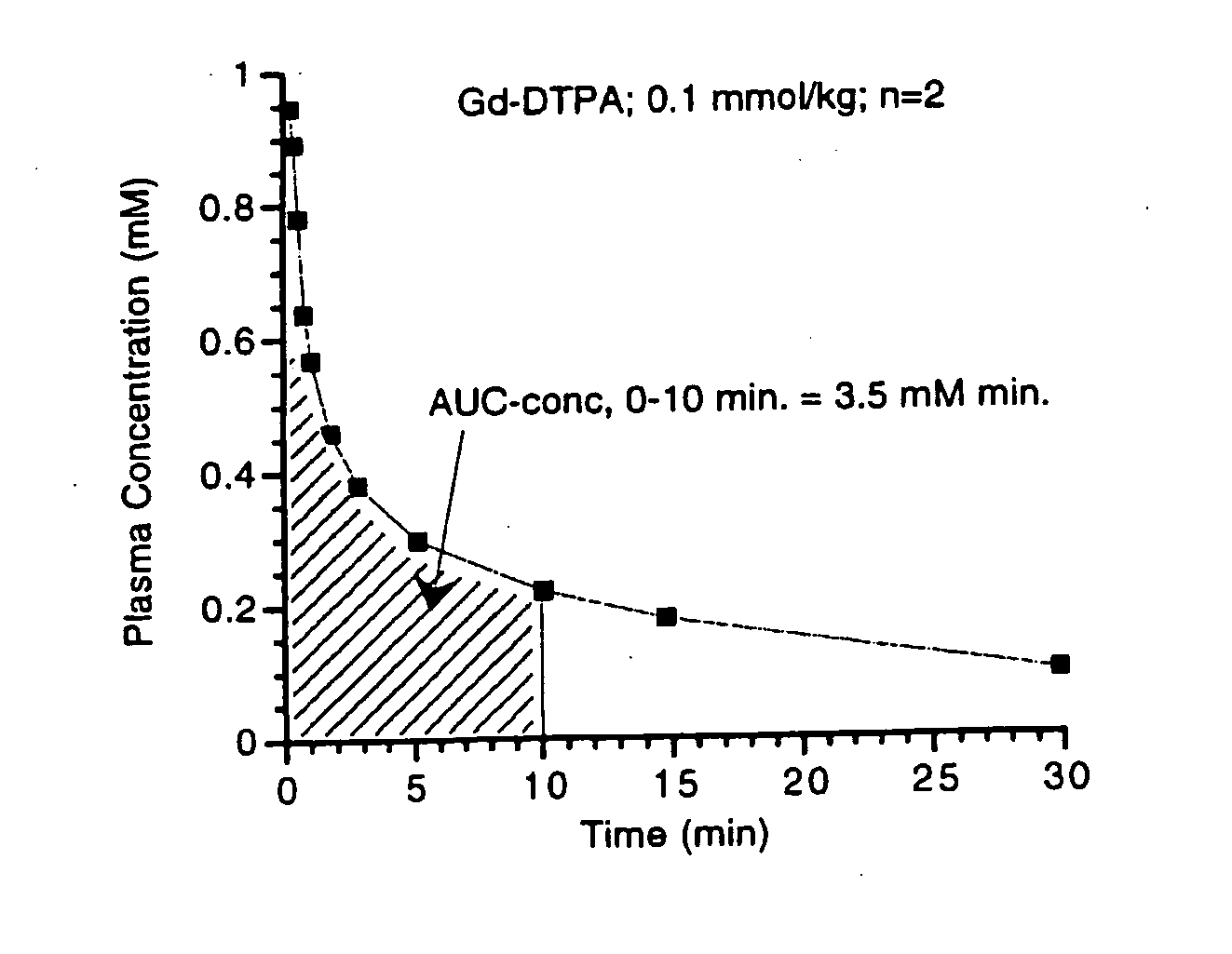Contrast-enhanced diagnostic imaging method for monitoring interventional therapies
a diagnostic imaging and contrast enhancement technology, applied in the field of contrast enhancement diagnostic imaging, can solve the problems of limited sensitivity to thermally-induced tissue temperature changes, virtually no direct information regarding the pathological state of the tissue or tissue component undergoing interventional therapy, and limited methods for monitoring thermal ablation therapies. achieve the effect of increasing contras
- Summary
- Abstract
- Description
- Claims
- Application Information
AI Technical Summary
Benefits of technology
Problems solved by technology
Method used
Image
Examples
example 1
Monitoring the Thermal Necrosis of 4.5% HSA
[0170] The following three samples were prepared in solutions of −4.5% HSA: (1) a control sample without a contrast agent; (2) a comparative sample with Gd-DTPA; and (3) a sample with MS-325. The samples with Gd-DTPA and MS-325 were prepared by adding an aqueous formulation (pH=7) comprising either Gd-DTPA or MS-325 to the 4.5% HSA solution. The resulting mixtures had a concentration of 0.3 mM Gd-DTPA and 0.1 mM MS-325, respectively.
[0171] The three samples were then used to monitor the thermal denaturation of the 4.5% HSA solutions. To do this, T1 data (and thus R1 data (=1 / T1)) for each sample was collected at 20 MHz over a temperature range of 20-60° C. Each sample was then removed from the NMR and heated at 85° C. for 15 minutes to induce thermal denaturation of the HSA. Subsequently, the sample was returned to the NMR and T1 data was collected at this higher temperature. See Table 1 below and FIG. 1.
TABLE 1Temperature(° C.)R1 4.5% ...
example 2
MRI Imaging of the Thermal Denaturation of HSA at 1.0 Tesla
[0174] The following samples were prepared in 1% agar gels containing 4.5% HSA: (1) a control sample without a contrast agent; (2) a comparative sample with Gd-DTPA; and (3) a sample with MS-325. The contrast agents were added in an amount sufficient such that the concentration of Gd-DTPA and MS-325 were 0.3 mM Gd-DTPA and 0.1 mM MS-325, respectively. Such agar gels containing 4.5% HSA are referred to as “phantoms”.
[0175] Initial T1-weighted MRI scans (FISP-3D, TR=15, TE=4, alpha=30) at 1.0 Tesla of the agar phantoms were then obtained at a temperature of about 25° C. The initial scans revealed that the phantoms containing MS-325 were brighter than the phantoms containing Gd-DTPA (comparative sample) or 4.5% HSA alone (control sample); this result was as expected due to the specific binding of MS-325 to HSA.
[0176] The phantoms were then heated in a circulating water bath with additional T1-weighted MRI scans obtained over...
example 3
Ethanol Denaturation of HSA
[0180] The following three samples were prepared in solutions of 4.5% HSA: (1) a control sample without a contrast agent; (2) a comparative sample with Gd-DTPA; and (3) a sample with MS-325. The samples with Gd-DTPA and MS-325 were prepared by adding an aqueous formulation (pH=7) comprising either Gd-DTPA or MS-325 to the 4.5% HSA solution. The resulting mixtures had a concentration of 0.31 mM Gd-DTPA and 0.08 mM MS-325, respectively.
[0181] Absolute ethanol was then titrated to each of the samples. T1 data (and thus R1 data (=1 / T1)) was collected at 20 MHz and 37° C. after each addition of ethanol. See Table 3 below and FIG. 3.
TABLE 3R1EthanolR1EthanolR1Ethanol4.5%(%) for0.31 mM(%) for0.08 mM(%)HSAGd-DTPAGd-DTPAMS-325MS-3250.0000−0.0000.04.17370.042.2168.73820.03016.14.71910.940.84816.0720.06027.85.00211.939.54122.3150.09036.64.93472.838.42327.6930.10943.54.79973.737.06432.3750.12549.04.46234.536.37536.4870.1285.435.23440.1280.1426.234.57643.3750.1537....
PUM
| Property | Measurement | Unit |
|---|---|---|
| atomic numbers | aaaaa | aaaaa |
| atomic numbers | aaaaa | aaaaa |
| atomic numbers | aaaaa | aaaaa |
Abstract
Description
Claims
Application Information
 Login to View More
Login to View More - R&D
- Intellectual Property
- Life Sciences
- Materials
- Tech Scout
- Unparalleled Data Quality
- Higher Quality Content
- 60% Fewer Hallucinations
Browse by: Latest US Patents, China's latest patents, Technical Efficacy Thesaurus, Application Domain, Technology Topic, Popular Technical Reports.
© 2025 PatSnap. All rights reserved.Legal|Privacy policy|Modern Slavery Act Transparency Statement|Sitemap|About US| Contact US: help@patsnap.com



